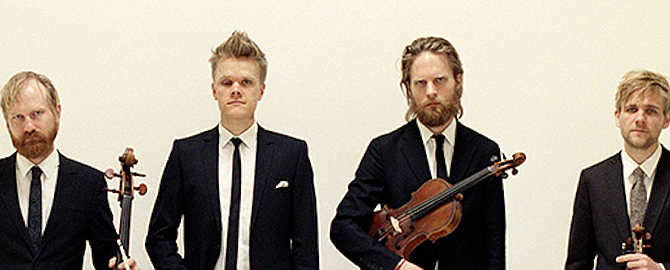 Facebook
Facebook
 X
X
 Instagram
Instagram
 TikTok
TikTok
 Youtube
Youtube

The Danish String Quartet is in residency at The La Jolla Music Society from November 16 through November 23. They are presenting five concerts as a part of their Prism project. The players in the quartet are Rune Tonsgaard Sørensen, violin; Frederik Øland, violin; Asbjørn Nørgaard, viola; Fredrik Schøyen Sjölin, cello.
I sat down with the quartet after their concert on Sunday, November 17, to discuss what Prism is. Violist Asbjørn Nørgaard explains:
“It’s a series of concerts that focuses on the late string quartets by Beethoven. There are five of them and they’re quite famous in the string quartet world, infamous almost. It’s a project which is centered around those pieces. Usually one of those quartets is the conclusion of the concert. It is the summit of the mountain. Our idea is to put one of those quartets in the middle like a prism. We shine a beam of light on them from Bach and this beam of light, or music, is then split into several directions. It’s a way to re-contextualize Beethoven.”
The quartet members continued to explain that each concert starts with a Bach fugue followed by a late Beethoven quartet and from there, the prism of Beethoven can go any which way to music which was influenced or inspired by Beethoven. This approach is new and makes Beethoven into the figure which, in many ways, he actually was.
During the Baroque, there were several different styles of composition. Bach is quite different from Handel who is far removed from Vivaldi or Telemann. In the classical period all composers were using the same style of composition which is best embodied by Mozart and Haydn. There was a narrowing of style.
Beethoven came out of that style but by the time he was composing his late quartets he himself had split in several different directional styles. After Beethoven it almost becomes a stylistic free-for-all.
A single, unified style goes into Beethoven yet out of Beethoven that style is split very much like light going into a prism.
I asked each of the quartet members to share one word which best describes their current, individual relationship to music.
Frederik Øland, violin: “I’d like to say intense. Sometimes it comes out as great energy and sometimes it is a struggle inside my head.”
Asbjørn Nørgaard, viola: “I would say on the move. Maybe movement?”
Fredrik Schøyen Sjölin, cello: "It’s so difficult because we’ve all been playing music since we were kids. Maybe something like continuation or exploration. Yes. Exploration. I like that.”
As Rune Tonsgaard Sørensen, violin, contemplated his word, the others threw out suggestions. “Vacuum. Nothings. Darkness. Money! Yes, money.”
After the suggestion calmed, Rune said, “Creativity.”


The Danish String Quartet is in residency at The La Jolla Music Society from November 16 through November 23. They are presenting five concerts as a part of their Prism project. The players in the quartet are Rune Tonsgaard Sørensen, violin; Frederik Øland, violin; Asbjørn Nørgaard, viola; Fredrik Schøyen Sjölin, cello.
I sat down with the quartet after their concert on Sunday, November 17, to discuss what Prism is. Violist Asbjørn Nørgaard explains:
“It’s a series of concerts that focuses on the late string quartets by Beethoven. There are five of them and they’re quite famous in the string quartet world, infamous almost. It’s a project which is centered around those pieces. Usually one of those quartets is the conclusion of the concert. It is the summit of the mountain. Our idea is to put one of those quartets in the middle like a prism. We shine a beam of light on them from Bach and this beam of light, or music, is then split into several directions. It’s a way to re-contextualize Beethoven.”
The quartet members continued to explain that each concert starts with a Bach fugue followed by a late Beethoven quartet and from there, the prism of Beethoven can go any which way to music which was influenced or inspired by Beethoven. This approach is new and makes Beethoven into the figure which, in many ways, he actually was.
During the Baroque, there were several different styles of composition. Bach is quite different from Handel who is far removed from Vivaldi or Telemann. In the classical period all composers were using the same style of composition which is best embodied by Mozart and Haydn. There was a narrowing of style.
Beethoven came out of that style but by the time he was composing his late quartets he himself had split in several different directional styles. After Beethoven it almost becomes a stylistic free-for-all.
A single, unified style goes into Beethoven yet out of Beethoven that style is split very much like light going into a prism.
I asked each of the quartet members to share one word which best describes their current, individual relationship to music.
Frederik Øland, violin: “I’d like to say intense. Sometimes it comes out as great energy and sometimes it is a struggle inside my head.”
Asbjørn Nørgaard, viola: “I would say on the move. Maybe movement?”
Fredrik Schøyen Sjölin, cello: "It’s so difficult because we’ve all been playing music since we were kids. Maybe something like continuation or exploration. Yes. Exploration. I like that.”
As Rune Tonsgaard Sørensen, violin, contemplated his word, the others threw out suggestions. “Vacuum. Nothings. Darkness. Money! Yes, money.”
After the suggestion calmed, Rune said, “Creativity.”
Comments